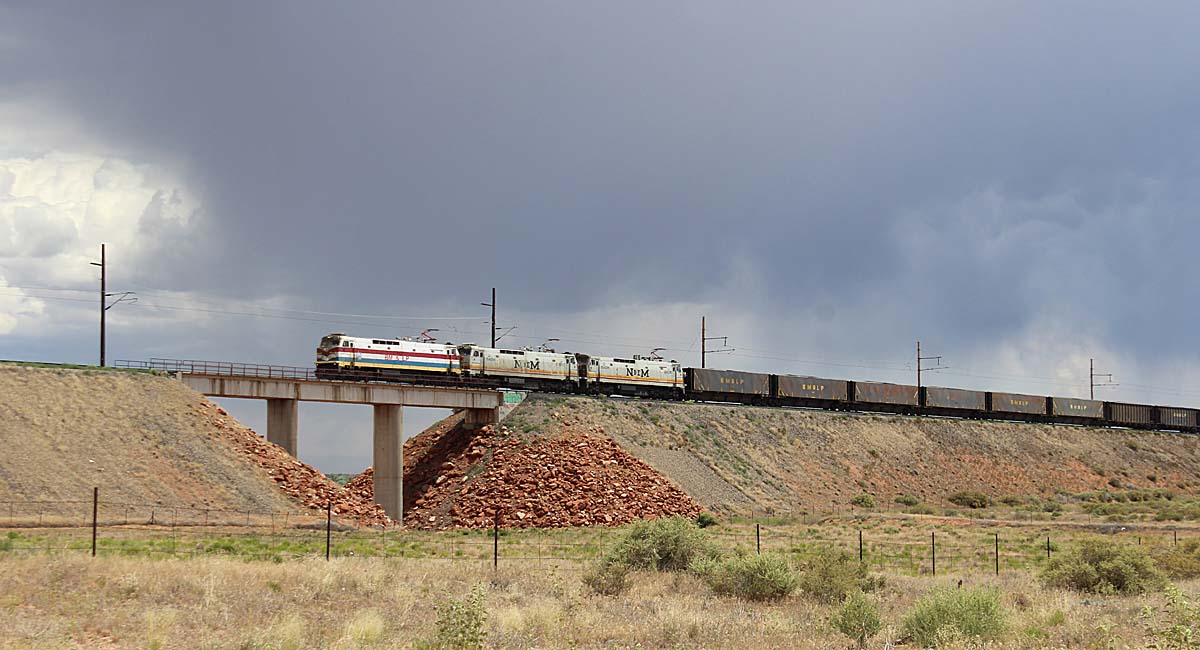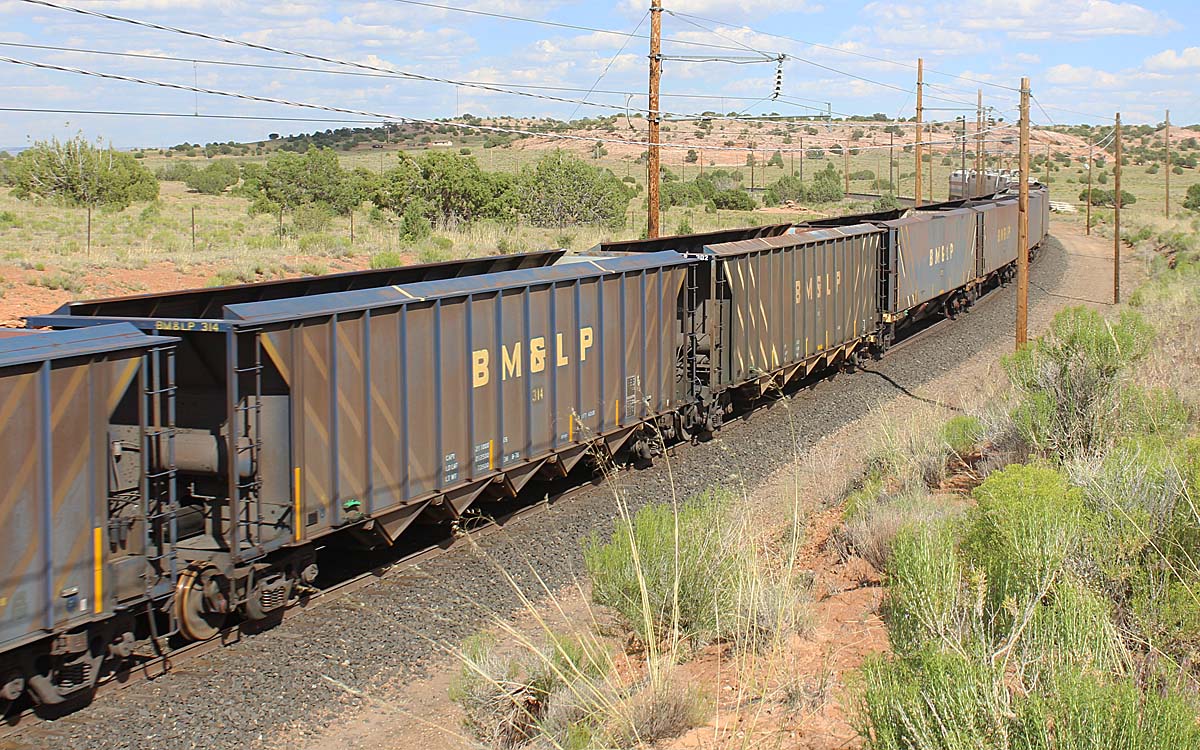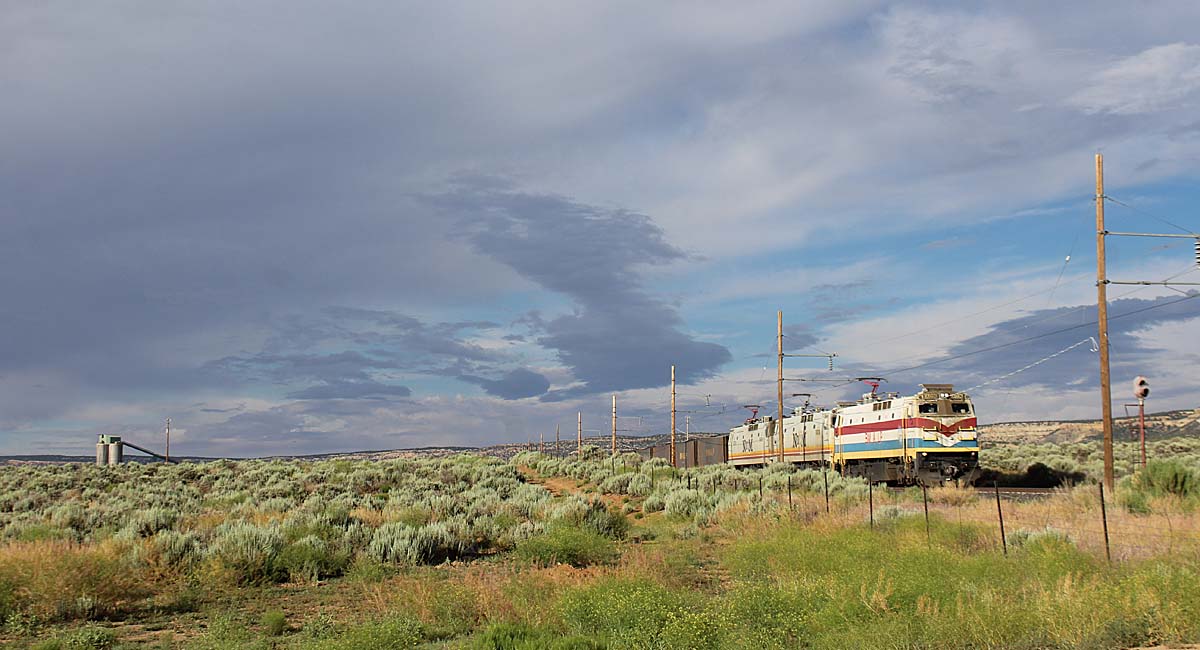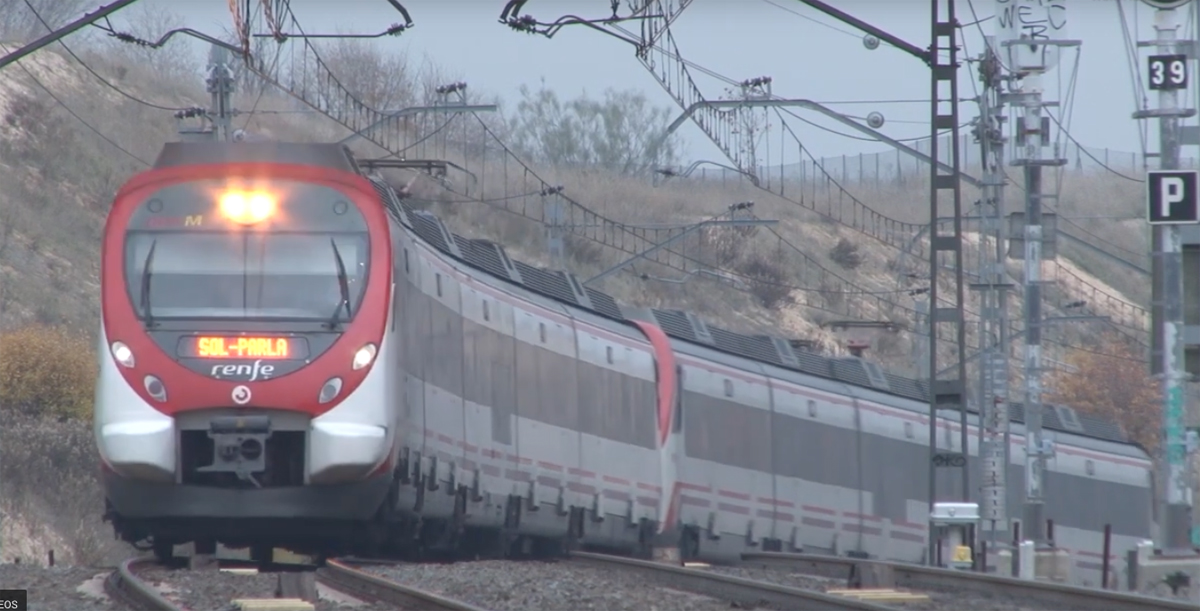Each day, except Wednesday, a single set of hoppers makes three round trips from the Navajo Generating Station, just east of Page, to the Black Mesa mine loadout southwest of Tsegi. Contrary to popular belief the Black Mesa & Lake Powell Railroad, which began operations in August 1973, is accessible and with all coal trains running on a schedule getting photos is as easy as it can be.
The coal train crews are on duty at 6 a.m, 2 p.m., and 10 p.m. and are ready to depart the power plant within one one hour, but the first departure of the day is occasionally delayed if the day shift crew has to run the previous night’s coal train through the dumper loop. Wednesday mornings are reserved for track and equipment maintenance, but visitors might get lucky and catch a ballast train or other non-revenue movement before the afternoon coal train departs.
The train is usually visible at the power plant from State Route 98. Without leaving the highway one can get great photos of the train with the power plant and Lake Powell in the background and then of the train moving into the open desert to the south. After the departing train passes to the south side of Route 98 there are several more good photo locations with red desert mesas in the background as the track slowly wanders away from the road. Be sure to bring a long lens with you as the distance steadily increases, but the train will remain in view off and on for many miles.
The empty coal trains move along at a steady 40 mph so there is no time to dawdle. There are several dirt roads that angle southwest from Route 98, but loose sand, mud, and deep ruts can slow travel significantly. If you take one of those side roads to the track you might not have time to get back on the highway and catch the train again.
Navajo Route 201 is one such road veering off of Route 98 as is the road leading toward the tracks closer to Page marked 12.9 indicating that it will take you to Black Mesa & Lake Powell milepost 12.9. In fact, most side roads are labeled with the milepost where they intersect with the railroad.
The Klethla Valley provides a variety of understated foreground and background scenery as you move along and the 40 mph train speed allows for many shots.
Drive respectfully so as not to coat the local residents with dust and watch out for livestock, including the photogenic stout little multicolored horses that are so well suited to the desert. The local residents are well aware of the likely closure of the line and are accepting of railfans, but please do not trespass as there is no need for it.
A word of caution, do not go into the desert without at least three gallons of potable water per person and tell someone where you are going and when you will be back. Do not count on having cell phone reception. The majority of locations are accessible with a low-clearance, front wheel drive car, but a high-clearance, four wheel drive vehicle would be handy access a few spots.
The train will slow down only as it approaches the beginning of the mine loading loop where there is another power switch. When the loading process and inspections are finished the conductor will ride in a company truck from the mine tipple to the head end.
Once on the move, the three or four 6,000-hp electrics will quickly accelerate the heavily loaded train up to the 40 mph track speed. They will have no trouble maintaining track speed down the relatively flat Klethla Valley and they will not get bogged down much even by the 0.8% climb up the fill and on past the bridge.
As the six electrics aged, the railroad bought eight Nacionales de México E60C-2 locomotives in 1999 that had been delivered to Mexico in 1982, but never used in regular service. Two were immediately relegated to serve as parts sources while the others were slowly converted from 25,000 volts to the Black Mesa & Lake Powell’s 50,000 volts.
Used aluminum rapid discharge hoppers were also purchased in recent years to supplement the original steel cars as their ranks were thinned by heavy use.
Three round trips a day over the 78 mile line equates to 468 miles per day or almost 3,200 miles a week if they take Wednesday morning off. If even one of those hoppers or one electric makes every trip for a year that is 166,296 miles.Few railroads in the U.S. can come close to that kind of equipment utilization, but even with that heavy wear, at least six of the original hoppers and one of the original E60Cs are still in service!

















Here are some run times that are handy for chasing coal trains
EASTBOUND EMPTY CYCLE
AZ98 underpass just east of power plant to Kaibeto Road Crossing 42 minutes
Kaibeto Road Crossing to White Mesa just past RR Overpass of Navajo route number 21
20 minutes
White Mesa to the Single Large Bridge along US 160 16 minutes
Bridge to Arrival at Mine 36 minutes
Loading and Inspection time 1 H to 1 H 40 M
WESTBOUND LOAD CYCLE
Departing Mine to Bridge 30 to 45 M depending on how aggressively they accelerate and weight of train vs power (3 or 4 electrics).
Bridge to the view of the RR near the White Mesa Arch 18 minutes
White Mesa area to Kaibeto road crossing 22 minutes
Kaibeto road crossing to S Curves visible from AZ 98 36 minutes roughly as this is starting into the steeper downgrade.
From the S Curves to the RR underpass of AZ 98 near the power plant another 25 to 36 minutes.
This is on the long steep descent so run times vary due to careful train control instead of maintaining a strict speed.
It really is possible to spend all daylight hours following trains back and forth between the power plant and the mine with just enough break in the action to get gas and a snack.
During an average non Winter day there is enough light for the entire morning run and most of the afternoon run and on long Summer days it is possible to photograph both round trips in their entirety.
I hope this helps,
Andy
Navajo Route 21 is the key to following the entire line.
After leaving Page on AZ 98 turn off at Kaibeto and make a quick trip to the part of 21 going southwest to get photos of the train at the crossing. Then backtrack to Kaibeto and follow 21 to US 160. Along the way you can get photos of the coal trains passing over 21 and then going east in front of the White Mesa
You can also use Navajo 213 and 215 to get to the only passing siding on this line
Muskingum Electric was in Ohio
Bruce: Never cheap when air quality and human life factored in.; always dirty. 19th Century fuel only.
The BM&LP began as an automated operation in 1974. It had a operator who only rode in the cab. Later, manual operation was utilized due to problems with the early automation system. It followed automated operations on Canada’s Iron Ore Co. (IOCO) in 1962 (Labrador) and Muskingum Electric (owned by American Electric Power) in Pennsylvania, 1969.
As a side note, TRAINS January 1959 had a story about Union Pacific’s experiment with radio remote control (not automation) on a steam engine in Omaha in 1914.
Coal, our most plentiful natural resource, is now going to waste. Cheap electrical power from coal is shunned. Besides being burnt to generate electricity, coal has served us well in the development of many natural medicines.
Twisted science wins again.
I often wondered, if using electric locomotives was cheaper then using diesels? It seems like after early experimentation with Electric locomotives in the early 20th century, the use of them never seem to really catch on
in the US nation wide
https://www.scientificamerican.com/article/and-now-the-really-big-coal-plants-begin-to-close/
Years ago I stumbled upon the BM&LP while driving through Kayenta while returning from Moab, Utah. At the time I had no idea it was there, and little notion of what it was. An email to a Trains assistant editor got me my answer, and then just shortly after that, Trains ran a piece on the railroad. I hate to see something unique like that just go away. Electrified lines are rare in the US, rarer still in the west. Could it be turned into a tourist train? Anything is possible, but it is unlikely.
Jim, I believe the power plant is shutting down by the end of the year
I must have missed it. Why is the railroad stopping operations?
The property goes back to the Navajo Nation, they want to keep it for future uses (tourist trains?)
A very impressive operation, will be interesting to see how the equipment is disposed of.